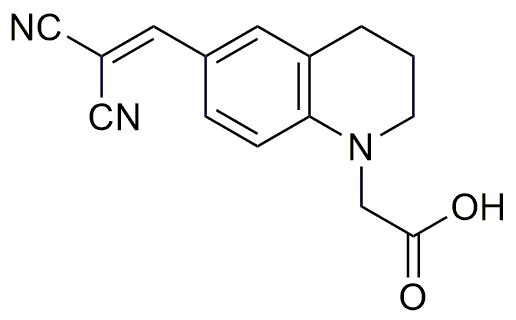N-Carboxymethyl-6-(2,2-dicyanovinyl)-1,2,3,4-tetrahydroquinoline is widely utilized in research focused on:
- Organic Synthesis: This compound serves as a versatile building block in organic chemistry, allowing researchers to create complex molecules efficiently.
- Pharmaceutical Development: Its unique structure makes it a candidate for developing new drugs, particularly in targeting specific biological pathways, enhancing therapeutic efficacy.
- Material Science: The chemical is used in the formulation of advanced materials, such as polymers and coatings, which benefit from its stability and reactivity.
- Photovoltaic Applications: It can be incorporated into solar cell technologies, improving energy conversion efficiency due to its electronic properties.
- Fluorescent Probes: This compound is effective in creating fluorescent probes for biological imaging, allowing for enhanced visualization of cellular processes.
Informations générales
Propriétés
Sécurité et réglementation
Applications
N-Carboxymethyl-6-(2,2-dicyanovinyl)-1,2,3,4-tetrahydroquinoline is widely utilized in research focused on:
- Organic Synthesis: This compound serves as a versatile building block in organic chemistry, allowing researchers to create complex molecules efficiently.
- Pharmaceutical Development: Its unique structure makes it a candidate for developing new drugs, particularly in targeting specific biological pathways, enhancing therapeutic efficacy.
- Material Science: The chemical is used in the formulation of advanced materials, such as polymers and coatings, which benefit from its stability and reactivity.
- Photovoltaic Applications: It can be incorporated into solar cell technologies, improving energy conversion efficiency due to its electronic properties.
- Fluorescent Probes: This compound is effective in creating fluorescent probes for biological imaging, allowing for enhanced visualization of cellular processes.
Documents
Fiches de données de sécurité (FDS)
La FDS fournit des informations de sécurité complètes sur la manipulation, le stockage et l’élimination du produit.
Spécifications du produit (PS)
Le PS fournit une description complète des propriétés du produit, notamment sa composition chimique, son état physique, sa pureté et les exigences de stockage. Il détaille également les plages de qualité acceptables et les applications prévues du produit.
Certificats d'analyse (COA)
Recherchez des certificats d'analyse (COA) en saisissant le numéro de lot du produit. Les numéros de lot et de lot se trouvent sur l'étiquette d'un produit, après les mots « Lot » ou « Lot de fabrication ».
Numéro de catalogue
Numéro de lot/série
Certificats d'origine (COO)
Ce certificat d'exploitation confirme le pays dans lequel le produit a été fabriqué, et détaille également les matériaux et composants utilisés et s'il est issu de sources naturelles, synthétiques ou autres sources spécifiques. Ce certificat peut être requis pour les douanes, le commerce et la conformité réglementaire.
Numéro de catalogue
Numéro de lot/série
Fiches de données de sécurité (FDS)
La FDS fournit des informations de sécurité complètes sur la manipulation, le stockage et l’élimination du produit.
DownloadSpécifications du produit (PS)
Le PS fournit une description complète des propriétés du produit, notamment sa composition chimique, son état physique, sa pureté et les exigences de stockage. Il détaille également les plages de qualité acceptables et les applications prévues du produit.
DownloadCertificats d'analyse (COA)
Recherchez des certificats d'analyse (COA) en saisissant le numéro de lot du produit. Les numéros de lot et de lot se trouvent sur l'étiquette d'un produit, après les mots « Lot » ou « Lot de fabrication ».
Numéro de catalogue
Numéro de lot/série
Certificats d'origine (COO)
Ce certificat d'exploitation confirme le pays dans lequel le produit a été fabriqué, et détaille également les matériaux et composants utilisés et s'il est issu de sources naturelles, synthétiques ou autres sources spécifiques. Ce certificat peut être requis pour les douanes, le commerce et la conformité réglementaire.


